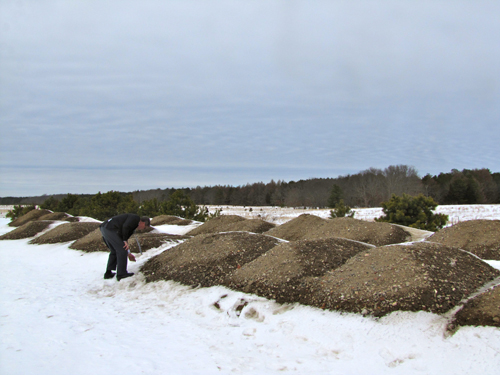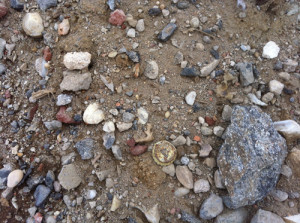Contaminated EPCAL fill could cost town over $15K to remove

About a month after test results showed material dumped at Enterprise Park at Calverton contained traces of DDT, asbestos and other chemicals, the town learned this week that the state Department of Environmental Conservation is recommending complete removal of the material from the town-owned land.
And while no fines seem imminent, the cost of taking the unqualified material the town got for free — from testing the fill to dumping it — could come at a cost of over $15,000.
According to a letter from the DEC, “based on a review of the results and the site inspection by Department staff, we recommend that all material be removed from the site and disposed of at a permitted landfill.”
The letter then lists three landfills on Long Island at which the town can dispose of the material: the Town of Brookhaven Landfill in Yaphank, a private disposal site in Melville called 110 Sand Company, and the Town of Islip’s Blydenburgh Landfill in Hauppauge.
 Riverhead Supervisor Sean Walter said Tuesday that he didn’t foresee any fines coming from the DEC, despite the fact that the DEC observed the town likely took fill from an unauthorized facility.
Riverhead Supervisor Sean Walter said Tuesday that he didn’t foresee any fines coming from the DEC, despite the fact that the DEC observed the town likely took fill from an unauthorized facility.
DEC officials confirmed on Tuesday that no fines had been issued over the material.
According to assistant town engineer Drew Dillingham, 300 tons were dumped in total on town land. The town now has to foot the bill to have it taken elsewhere. According to Mr. Dillingham, the Hauppauge facility would charge the town $35 a ton, for a total of $10,500, to take the fill. Islip’s facility will take it at a cost of $65 per ton, or a total of $19,500. Brookhaven hasn’t given the town a final estimate yet, though it could be as low as $25 per ton. Those numbers would not include fuel to transport the facility using town resources, or the labor involved, Mr. Dillingham noted.
“This could be a $15,000 screw up,” said Mr. Walter. “That’s a big deal. People have gotten fired over a lot less. Believe me.”
Highway Superintendent George ‘Gio’ Woodson, a Democrat, took the blame for accepting the material, though he said on Tuesday that he suspected politics was at play to make him look bad.
“I can go out, find asbestos, and bring it in and say, ‘Oh I found this,’” Mr. Woodson said. “Where’s the chain of custody?”
Mr. Woodson was referring to a discussion the all-Republican Town Board had about the fill in late February, when Mr. Woodson first publicly admitted to taking the fill from a Southampton facility. Councilman George Gabrielsen had laid some of the material on a table, saying there appeared to be asbestos tiles in the mix.
Mr. Gabrielsen said this week that there should be “no conspiracy theory.”
“I was down at the site and I picked it up knowing what an asbestos shingle looked like,” he said.
The supervisor said pesticides found in the fill is a bigger environmental problem than asbestos anyway.
“Asbestos doesn’t leech,” he said.
While 3.3 parts per billion of DDT is considered a standard for unrestricted use, two samples taken in the piles showed levels of 36.3 and 19.3 parts per billion. Another pesticide, dieldrin — developed as an alternative to DDT — tested 12 times the limit near the East runway at EPCAL.
Upon removal of the fill, the town has to provide the DEC with receipts proving disposal of the material.
If the town does not move the material, according to DEC spokesman Jomo Miller, the “DEC will have to weigh its options and determine the appropriate next steps.”








